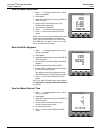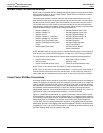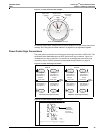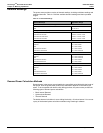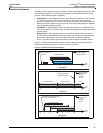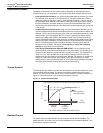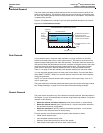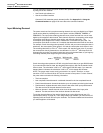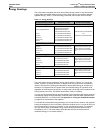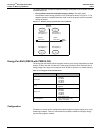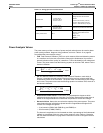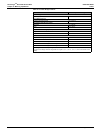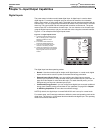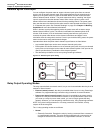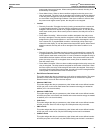
© 2011 Schneider Electric. All Rights Reserved.
PowerLogic
TM
Series 800 Power Meter 63230-500-225A2
Chapter 4—Metering Capabilities 3/2011
34
You can reset the minimum and peak values of the quantities in a generic demand profile
by using one of two methods:
• Use PowerLogic software, or
• Use the command interface.
Command 5115 resets the generic demand profile. See Appendix C—Using the
Command Interface on page 83 for more about the command interface.
Input Metering Demand
The power meter has five input pulse metering channels, but only one digital input. Digital
inputs can be added by installing one or more option modules (PM8M22, PM8M26, or
PM8M2222). The input pulse metering channels count pulses received from one or more
digital inputs assigned to that channel. Each channel requires a consumption pulse weight,
consumption scale factor, demand pulse weight, and demand scale factor. The
consumption pulse weight is the number of watt-hours or kilowatt-hours per pulse. The
consumption scale factor is a factor of 10 multiplier that determines the format of the value.
For example, if each incoming pulse represents 125 Wh, and you want consumption data in
watt-hours, the consumption pulse weight is 125 and the consumption scale factor is zero.
The resulting calculation is 125 x 10
0
, which equals 125 watt-hours per pulse. If you want
the consumption data in kilowatt-hours, the calculation is 125 x 10
-3
, which equals 0.125
kilowatt-hours per pulse.Time must be taken into account for demand data; so you begin by
calculating demand pulse weight using the following formula:
If each incoming pulse represents 125 Wh, using the formula above you get 450,000 watts.
If you want demand data in watts, the demand pulse weight is 450 and the demand scale
factor is three. The calculation is 450 x 10
3
, which equals 450,000 watts. If you want the
demand data in kilowatts, the calculation is 450 x 10
0
, which equals 450 kilowatts.
NOTE: The power meter counts each input transition as a pulse. Therefore, an input
transition of OFF-to-ON and ON-to-OFF will be counted as two pulses. For each channel,
the power meter maintains the following information:
• Total consumption
• Last completed interval demand—calculated demand for the last completed interval.
• Partial interval demand—demand calculation up to the present point during the interval.
• Peak demand—highest demand value since the last reset of the input pulse demand.
The date and time of the peak demand is also saved.
• Minimum demand—lowest demand value since the last reset of the input pulse
demand. The date and time of the minimum demand is also saved.
To use the channels feature, first use the display to set up the digital inputs (see “I/O
(Input/Output) Setup” on page 18). Then using PowerLogic software, you must set the I/O
operating mode to Normal and set up the channels. The demand method and interval that
you select applies to all channels.
watts
watt-hours
pulse
----------------------------
3600 seconds
hour
-------------------------------------
pulse
second
-------------------
=



